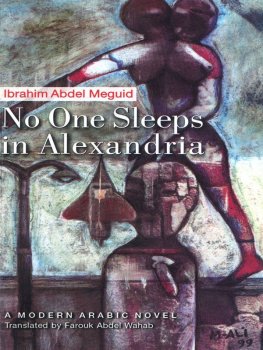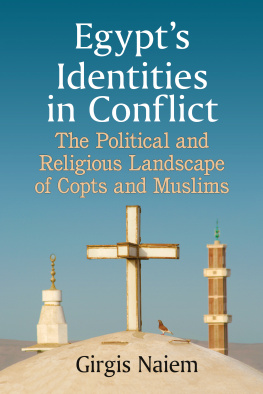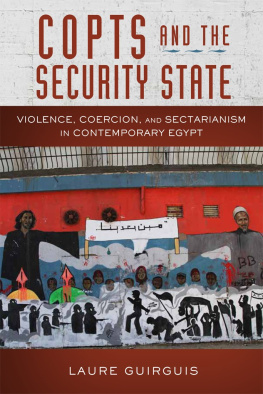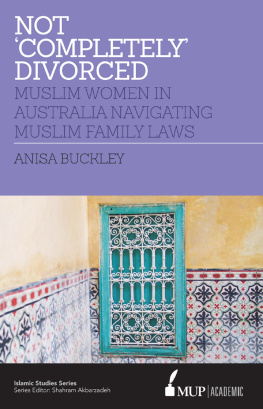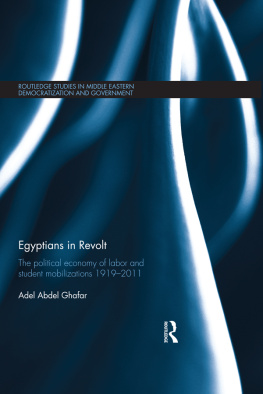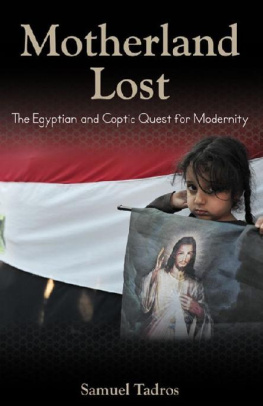ROUTLEDGE LIBRARY EDITIONS: EGYPT
THE COPTS IN EGYPTIAN POLITICS 19181952
THE COPTS IN EGYPTIAN POLITICS 19181952
B. L. CARTER
Volume 11
First published in 1986
This edition first published in 2013
by Routledge
2 Park Square, Milton Park, Abingdon, Oxon, OXI4 4RN
Simultaneously published in the USA and Canada
by Routledge
711 Third Avenue, New York, NY 10017
Routledge is an imprint of the Taylor & Francis Group, an informa business
1986 B. L. Carter
All rights reserved. No part of this book may be reprinted or reproduced or utilised in any form or by any electronic, mechanical, or other means, now known or hereafter invented, including photocopying and recording, or in any information storage or retrieval system, without permission in writing from the publishers.
Trademark notice: Product or corporate names may be trademarks or registered trademarks, and are used only for identification and explanation without intent to infringe.
British Library Cataloguing in Publication Data
A catalogue record for this book is available from the British Library
ISBN: 978-0-415-63747-3 (Set)
eISBN: 978-0-203-07914-0 (Set)
ISBN: 978-0-415-81124-8 (Volume 11)
eISBN: 978-0-203-06936-3 (Volume 11)
Publisher's Note
The publisher has gone to great lengths to ensure the quality of this reprint but points out that some imperfections in the original copies may be apparent.
Disclaimer
The publisher has made every effort to trace copyright holders and would welcome correspondence from those they have been unable to trace.
THE COPTS IN EGYPTIAN POLITICS 19181952
B. L. CARTER
THE AMERICAN UNIVERSITY IN CAIRO PRESS
Copyright 1986 by B. L. Carter
This edition published by arrangement with Croom Helm Ltd., Provident House, Burrell Row, Beckenham, Kent BR3 1AT, United Kingdom
First published in Egypt in 1988 by
The American University in Cairo Press
113, Sharia Kasr el Aini
Cairo, Egypt
All rights reserved. No part of this publication may be reproduced, stored in a retrieval system, or transmitted in any form or by any means, electronic, mechanical, photocopying, recording or otherwise, without the prior written permission of the copyright owner.
Dar el Kutub No. 7049/87
ISBN 977 424 174 6
Printed in Egypt by The American University in Cairo Press
Contents
ACKNOWLEDGEMENTS
I wish to record here my gratitude for the help, kindness and hospitality offered by so many Egyptians during my two-year stay in their country and on subsequent visits. I want principally to thank Mirrit Boutros Ghali, Director of the Coptic Arch-eological Society, and his cousin, the late historian, Ibrahim Amin Ghali. Both gave freely of their time and knowledge. There were many others who also suffered my questions with patience and, among them, I would like to thank Louis Awad, Iris Habib al-Masri, Afaf Mahfuz and Sad Fakhri Abd al-Nur. I am also grateful to Nazek Farag Amin who shared her considerable knowledge of the Egyptian archives and helped greatly with introductions.
I am particularly indebted to two individuals who kept me company throughout much of this endeavour. To fellow-researcher Charles Tripp, I am grateful for a generous willingness to share and discuss ideas, information and sources and, on a more practical note, for many a cleared space on an Egyptian bus. My thanks also to Janet Marks who prepared the thesis for presentation, the manuscript for publication, and undertook many of the related administrative tasks which I, working in Yemen, could not have carried out.
I should also like to express my appreciation for the financial help of three institutions: the American Research Center in Egypt, the School of Oriental and African Studies, University of London, and the American Friends Service Committee in Philadelphia. Each funded a part of the research and writing. Without their generous support, this work would have been abandoned early.
My greatest thanks are reserved for my academic supervisor, Professor P.J. Vatikiotis, who has mastered the art of giving advice over great distances. His cheerfulness in the face of a several years1 barrage of complaining, confused, anxious and speculative letters has remained constant, as has his willingness to help. It is with some relief that I am finally able to lift from him the burden of further support.
I wish to note here that Barth's Introduction in Frederik Barth (ed.), Ethnic Groups and Boundaries (Allen and Unwin, London, 1970), helped shape my thinking about the Coptic community.
Finally, let me enter the usual reminder here -there are many to whom credit is due for whatever is found praiseworthy in this thesis; the shortcomings, however, remain mine alone.
B.L. Carter
Sanaa,
Yeman Arab Republic, 1984
NOTE ON TRANSLITERATION AND ABBREVIATIONS
Arabic words have been transliterated largely according to the system used in the International Journal of Middle Eastern Studies . However, at the recommendation of the publisher, diacritical marks and the symbols for the letters Cain and hamza were deleted. It is to be hoped that the reader who knows Arabic does not find these omissions confusing or, in some instances, amusing. A few Coptic names, which are not of Arabic origin have been transliterated into a more recognisable form. The main examples here are the names of three great churchmen: Sergius, Makarios and Cyril. In addition, some Egyptian place names, which have long been familiar to the English-speaking world, have been left in their standard form. These names include Cairo, Alexandria, Suez, Damietta and Luxor.
Various source abbreviations have been used in the footnotes, and these are explained below:
| Egyptian Archives |
| CAS | Coptic Archaeological Society, Cairo. (The Society has a small library.) |
| CCEH | Centre for Contemporary Egyptian History and Documentation (Markaz Wathaiq wa Tarikh Misr al-Muasir), Dar al-Kutub, Cairo. |
| F = File Cabinet. |
| D = Drawer (From 197779, these cabinets rested against one wall, but may now have been moved. They contained a handwritten card index to some of the Abdin Palace archives.) |
| Chamber Debates | Madabit |
| Madabit Majlis al-Nuwwab, Parliament Library, Cairo. |
| DM | Dar al-Mahfuzat, Citadel, Cairo. |
| DW | Dar al-Wathaiq, Citadel, Cairo. |
| PPF | Palace Press Files, CCEH, Dar al-Kutub, Cairo. |
| Senate Debates | Madabit |
| Majlis al-Shuyukh, Parliament Library, Cairo. |
| Foreign Archives |
| CMS | Church Missionary Society, London. |
| LD | Lampson/Killearn Diaries, Middle East Centre, St. Antony's College, Oxford University. |
| PHS | Presbyterian Historical Society, Philadelphia, Pennsylvania, USA. |
Introduction
A. THE PROBLEM
In a polity whose raison d'tre was the perfection of a society in which Muslims could fulfil their religious obligations, the place of indigenous non-Muslims posed both theoretical and practical problems. How should such a polity deal with those who had been exposed to Islam and yet declined to accept its manifest truth? There were too many non-Muslims and they performed functions, particularly in Egypt, that were too critical to the well-being of the state to be either forcibly converted en masse or exterminated. Religion was already a political determinent. It became a social and economic determinent as well and set an individual's status, friendships, tax, entitlement to government benefits, code of law and sometimes even profession and living quarters. Non-Muslims were not citizens in the full sense because loyalty to the State and to the State's religion were inextricable.1 They were not trustworthy, and therefore Muslims required some protection from them.


